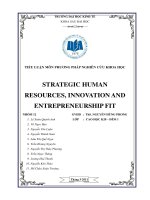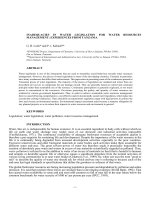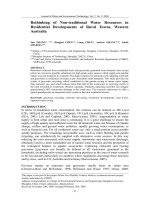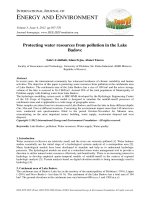20130417123848708 mineral resources
Bạn đang xem bản rút gọn của tài liệu. Xem và tải ngay bản đầy đủ của tài liệu tại đây (1.38 MB, 48 trang )
Mineral metabolism
Functions of Minerals
• Some participate with enzymes in
metabolic processes (cofactors, e.g. Mg,
Mn, Cu, Zn, K)
• Some have structural functions (Ca, P in
bone; S in keratin)
• Acid-base and water balance (Na, K, Cl)
• Nerve & muscle function (Ca, Na, K)
• Unique functions: hemoglobin (Fe),
Vitamin B12 (Co), thyroxine (I).
Classification
• Macro or Major
minerals
– Sodium (Na),
potassium (K),
magnesium (Mg),
calcium (Ca),
phosphorus (P), sulfur
(S), chloride (Cl)
• Present in body tissues
at concentrations >50
mg/kg
• requirement of these is
>100 mg/d
• Micro or Trace minerals
(body needs relatively
less)
– Manganese(Mg), iron(Fe),
cobalt(Co), chromium(Cr),
molybdenum(Mo),
copper(Cu), zinc(Zn),
fluoride(F), iodine(I),
selenium(Se)
• Present in body tissues
at concentrations <50
mg/kg
• requirement of these is ﹤
100 mg/d
Nutritionally Important Minerals
Macro
Element
Trace
g/kg
Element
mg/kg
Ca
15
Fe
20-50
P
10
Zn
10-50
K
2
Cu
1-5
Na
1.6
Mo
1-4
Cl
1.1
Se
1-2
S
1.5
I
0.3-0.6
Mg
0.4
Mn
0.2-0.5
Co
0.02-0.1
Minerals in Foods
Oxalate
• Found in all food groups.
• More reliably found in animal
products.
• Often other substances in foods
decrease absorption
(bioavailability) of minerals
– Oxalate, found in spinach, prevents
absorption of most calcium in
spinach.
– Phytate, form of phosphorous in
most plants makes it poorly available
Phytate
Factors Affecting Requirements
• Physiological state/level of production
• Interactions with other minerals
Deficiencies and Excesses
• Most minerals have an optimal range
– Below leads to deficiency symptoms
– Above leads to toxicity symptoms
• Mineral content of soils dictates mineral
status of plants (i.e., feeds)
• May take many months to develop
Requirements and Toxicities
Element
Cu
Cattle
Requirement
, mg/kg
5-8
Co
Swine
Cattle
6
0.06
250
60
I
Livestock
0.1
?
Cattle
0.1
3-4
Horses
0.1
5-40
Se
Species
Toxic level,
mg/kg
115
Calcium (Ca)
• Most abundant mineral
in animal tissues
– 99% Ca in skeleton
– 1% Present in:
• Blood & other tissues
• Lots of functions
–
–
–
–
–
Bone structure
Nerve function
Blood clotting
Muscle contraction
Cellular metabolism
Dietary requirements
• Dietary requirements:
– Adult : 800 mg/day;
– Women during pregnancy, lactation and postmenopause: 1.5 g/day;
– Children (1-18 yrs): 0.8-1.2 g/ day;
– Infants: (< 1 year): 300-500 mg /day
• Food Sources:
– Best sources: milk and milk product;
– Good sources: beans, leafy vegetables, fish,
cabbage, egg yolk.
•
Absorption of calcium:
–
in small intestine (duodenum), first half jejunum against
electrical and concentration gradient, by an energy
dependent active process, which influenced by several
factors.
Mechanism
Simple diffusion
An active transport involving Ca pump
Factor promoting Ca absorption
1. Vit.D induce the synthesis of Ca binding protein in
the intestinal epithelial cells and promotes Ca
absorption.
2. Parathyroid hormone (PTH) enhances Ca absorption
through the increased synthesis of calcitriol.
3. Acidity (low pH) is more favorable for Ca absorption.
4. Lactose promotes calcium uptake by intestinal cell.
5. Lysine and arginine facilitate Ca absorption.
Factor inhibiting Ca absorption
1. Phytates and oxalates form insoluble salts and
interfere with Ca absorption.
2. The high content of dietary phosphate results in the
formation of insoluble Ca phosphate and prevent Ca
uptake.
Dietary ratio of Ca : P ---1:1 to 2:1--- is ideal for Ca absorption.
3. The free fatty acids are react with Ca to form
insoluble Ca soaps.
4. The alkaline condition (high pH) is unfavorable for
Ca absorption.
5. High content of dietary fiber interferes with Ca
absorption.
6. Low estrogen levels (postmenopausal women)
• Plasma calcium:
normal range: 9-11 mg% (2.25-2.75 mmol/L)
Three forms of plasma calcium:
① Ionized Ca (diffusible): about 50% is ionized from which
functionally the most active.
② Complex Ca with organic acid (diffusible): about 10% is
found in association with citrate or phosphate.
③ Protein bound Ca (non-diffusible): about 40% is found in
association with albumin and globulin.
Ca
[H+]
Protein
Ca
Ca [HCO3 ]
Ca
[H+]
[HCO3 ]
-
anion Ca
Factors Regulating Plasma Ca Level
• Plasma Ca is regulated variable
• Three hormones involved in regulation
– Calcitriol (1,25-(OH)2 VitD3, or 1,25 DHCC)
• from kidney
– Parathyroid hormone (PTH)
• from parathyroid gland
– Calcitonin(CT)
• from thyroid gland
• Vitamin D3 and PTH : increase plasma Ca↑
• Calcitonin : decrease plasma Ca↓
Calcitriol (1,25-dihydroxycholecalciferol, 1,25 DHCC)
Parathyroid hormone
(PTH)
• PTH is secreted by two pairs of
parathyroid glands.
• PTH is initially synthesized as a precursor,
preProPTH.
• Two proteolytic cleavages produce the
ProPTH and the secreted form of PTH (84
aa).
•The secretion of PTH
are promoted by low
Ca2+ concentration.
Mechanism of action of PTH
• PTH is the most
important endocrine
regulator of Ca and P
concentration.
• Function:
– elevate serum Ca level.
• PTH has 3 independent
tissues (bone, kidney and
intestine) to exert its
action.
Action on the bone
• Decalcification or
demineralization of
bone, carried out by
osteoclasts.
• →blood Ca level ↑
• Note: this is being
done at the expense of
loss of Ca from bone,
particularly in dietary
Ca deficiency.
(+)
Action on the kidney and intestine
• Action on the kidney: increase the Ca reabsorption.
• Action on the intestine: indirect, increase the intestine
absorption of Ca by promoting the synthesis of calcitriol.
Calcitonin (CT)
CT, 32aa, a hormone secreted by
parafollicular cells of thyroid gland, is
opposite to that of PTH.
•
• CT has the ability to decrease blood Ca and
P levels and its major target cells also in
bone, kidney and intestine.
1. bone: stimulate osteoclasts become
osteoblasts, osteogenesis.
2. intestine: inhibit absorption of Ca.
3. kidney: enhance of Ca excretion from urine.
Regulation of Calcium Homeostasis
Excretion of Ca
• Partly through the kidney.
• Mostly through the intestine.
• Notice: excretion of Ca into the feces is a
continuous process and this is increased in
vitamin D deficiency.
Calcium Deficiencies -Rickets
weakness and deformity of the bones that occurs from
vitamin D deficiency or dietary deficiency of Ca and P
in a growing person or animal.









